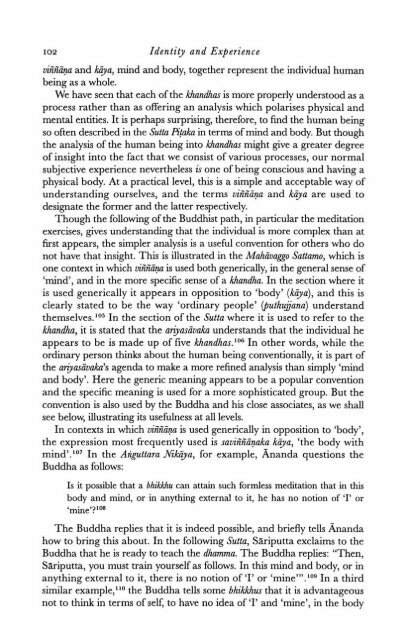Identity and Experience_Hamilton_1996
Identity and Experience_Hamilton_1996
Identity and Experience_Hamilton_1996
You also want an ePaper? Increase the reach of your titles
YUMPU automatically turns print PDFs into web optimized ePapers that Google loves.
102 <strong>Identity</strong> <strong>and</strong> <strong>Experience</strong><br />
vi55iy <strong>and</strong> kya, mind <strong>and</strong> body, together represent the individual human<br />
being as a whole.<br />
We have seen that each of the Wl<strong>and</strong>has is more properly understood as a<br />
process rather than as offering an analysis which polarises physical <strong>and</strong><br />
mental entities. It is perhaps surprising, therefore, to find the human being<br />
so often described in the Sutta @aka in terms of mind <strong>and</strong> body. But though<br />
the analysis of the human being into khan&as might give a greater degree<br />
of insight into the fact that we consist of various processes, our normal<br />
subjective experience nevertheless i~ one of being conscious <strong>and</strong> having a<br />
physical body. At a practical level, this is a simple <strong>and</strong> acceptable way of<br />
underst<strong>and</strong>ing ourselves, <strong>and</strong> the terms vi33ina <strong>and</strong> kga are used to<br />
designate the former <strong>and</strong> the latter respectively.<br />
Though the following of the Buddhist path, in particular the meditation<br />
exercises, gives underst<strong>and</strong>ing that the individual is more complex than at<br />
first appears, the simpler analysis is a useful convention for others who do<br />
not have that insight. This is illustrated in the Mahivaggo Sattarno, which is<br />
one context in which vin"n"i~ is used both generically, in the general sense of<br />
'mind', <strong>and</strong> in the more specific sense of a Wl<strong>and</strong>ha. In the section where it<br />
is used generically it appears in opposition to 'body' (kga), <strong>and</strong> this is<br />
clearly stated to be the way 'ordinary people' (puthujana) underst<strong>and</strong><br />
themsel~es.'~~ In the section of the Sutta where it is used to refer to the<br />
kh<strong>and</strong>ha, it is stated that the anyasivaka underst<strong>and</strong>s that the individual he<br />
appears to be is made up of five kh<strong>and</strong>has.lo6 In other words, while the<br />
ordinary person thinks about the human being conventionally, it is part of<br />
the anymivaka's agenda to make a more refined analysis than simply 'mind<br />
<strong>and</strong> body'. Here the generic meaning appears to be a popular convention<br />
<strong>and</strong> the specific meaning is used for a more sophisticated group. But the<br />
convention is also used by the Buddha <strong>and</strong> his close associates, as we shall<br />
see below, illustrating its usefulness at all levels.<br />
In contexts in which vin"n"ina is used generically in opposition to 'body',<br />
the expression most frequently used is saviKinaka kiija, 'the body with<br />
mind'.lo7 In the Ariguttara Nikga, for example, An<strong>and</strong>a questions the<br />
Buddha as follows:<br />
Is it possible that a bhikkhu can attain such formless meditation that in this<br />
body <strong>and</strong> mind, or in anything external to it, he has no notion of 'I' or<br />
'rnine'?'m<br />
The Buddha replies that it is indeed possible, <strong>and</strong> briefly tells An<strong>and</strong>a<br />
how to bring this about. In the following Sutta, Sariputta exclaims to the<br />
Buddha that he is ready to teach the dhamma. The Buddha replies: "Then,<br />
Sariputta, you must train yourself as follows. In this mind <strong>and</strong> body, or in<br />
anything external to it, there is no notion of 'I' or 'mine"'.10g In a third<br />
similar e~arnple,''~ the Buddha tells some bhikkhus that it is advantageous<br />
not to think in terms of self, to have no idea of 'I' <strong>and</strong> 'mine', in the body


